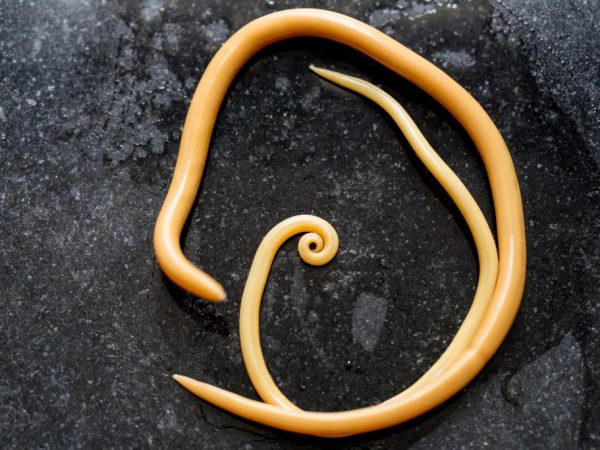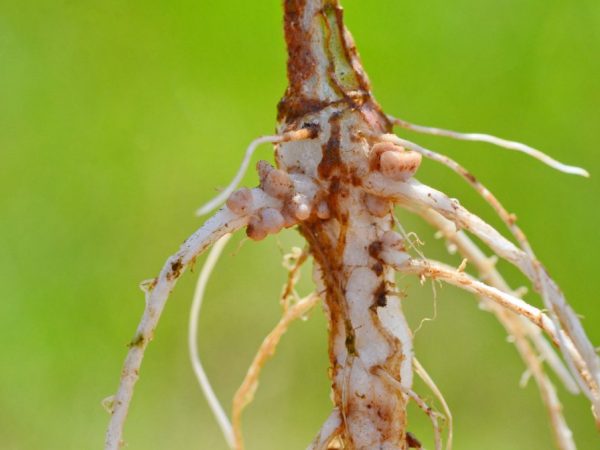Fighting golden potato nematode
An unpretentious vegetable crop such as potatoes can grow with little watering. Its various varieties show high yields on problem soils and in adverse climatic conditions, but they are often unable to withstand pests. The potato nematode causes significant damage to agriculture.

Fighting golden potato nematode
Pest appearance
Potato golden nematode is a type of small worm, no more than 1 mm long, which feeds on the juice of potato root crops and causes brown rot on the plant.
Due to its small size, it is possible to see what a golden pest looks like only under a microscope. Outwardly, this worm has a rounded spherical body in females and an elongated worm with a transparent tail in males.
There are 4 types of this pest in nature: potato stem nematode, golden, gallic and pale varieties.
The color of the golden female in the spring is predominantly white. By the onset of autumn, it darkens and turns brown. On the root system of a potato bush, it is attached with the help of the oral cavity and an organ located in it, called a spear. With the same spear, the golden potato nematode cuts through the vegetables and moves inside the root crops.
What is the danger of a nematode
Agricultural technicians consider the golden potato worm one of the most dangerous quarantine pests that harm plants and pose a threat to human health. With the naked eye, it is possible to see its clusters if you dig up an infected potato bush in the period after flowering. On the tubers shaken off the ground, blotches of a rounded shape will be visible - a female golden pest.
The danger of contamination of vegetable varieties lies in the impossibility of diagnosing the soil contaminated with it.
The offspring - cysts - retain their activity even during cold winter periods, they are able to withstand drought. Reproducing with great intensity, the pest can destroy almost the entire potato crop.
Infection of soil can occur for up to 6 years due to the gradual development of cysts. Without the adoption of timely methods of purification, the soil becomes a carrier of the pest for ten years, even without the plants present in it, serving as its nutrition.
At the end of winter, cysts of the golden potato nematode become the source of the appearance of juveniles, which look for potato tubers and begin to penetrate, settle there and go through their main stages of development. Sucking out potato juice, they lead to deformation of the leaves and stems of the potato.
Nematode harm
Like the Colorado potato beetle, wireworm and other pests, the potato disease caused by the golden nematode, which rapidly multiplies and spreads among tubers, causes significant damage to the future harvest, reducing its performance by 30-90%. Among the harm that a pest can do:
- deterioration in the taste characteristics of vegetables,
- poor flowering or its complete absence,
- shrinking tubers in potato varieties or their complete absence,
- restrictions on the export and sale of grown vegetables in places unfavorable for globoderosis.
Contributing factors

The reason may be a lack of trace elements in the soil.
The spread of the golden potato variety and the increase in the area of infection is facilitated by the annual cultivation of a vegetable crop in the same planting area and the associated violation of crop rotation. To increase the quantitative composition of the pest, the excessive saturation of the beds with nightshade crops and the excessive contamination of the land with weeds also allows.
Reduction of irrigation and a lack of micronutrients in the soil lead to the intensification of its activity.
Symptoms
It is often possible to recognize that a golden pest has settled on potatoes only at a critical stage of the disease. The first signs of the presence of potato golden nematode cysts will be:
- the appearance of bushes with yellow and sluggish leaves, which have suspended their development, the leaves begin to curl and dry in the lower part of the plant,
- in the affected bushes, only 1-3 shoots are formed, the shoots are deformed, have a pale color, the bushes die even before the harvest,
- the root system darkens to brown, begins to lag behind and forms numerous root processes.
Destruction methods
Among the methods, how and how to deal with the potato nematode, there are mechanical, biological and chemical. Preventive measures are not unimportant in measures to combat golden potato nematode.
Mechanical tricks
They involve manually digging up infected potato bushes and then destroying them. Removal of a bush from the garden is carried out together with a lump of soil in which the cysts have settled. Infected bushes need to be burned or filled with bleach. The dug hole is carefully covered with urea.
Biological techniques
Among the main measures that are recommended to be carried out in the fight against the pest:
- alternating planting of potatoes with plants that have deterrent properties - marigolds, rye, legumes, sweet clover, calendula,
- colonization of soil by predatory insects together with special soil, which provokes the appearance of an earthworm,
- fertilization of the soil with organic fertilizers in the spring.
Chemistry
Its use is assumed in case of detection of infection of the bushes. Systemically nematicides are used for extensive infection of planting areas. These chemicals can accumulate in the plant, causing pest poisoning. Urea is applied to the places where infected potato bushes are removed.
Not only bushes, but also seed material are subjected to chemical treatment. At the same time, during the pre-planting treatment of root crops, stimulants are used, which make the vegetable crop resistant to pests.
Prophylaxis
Due to the fact that the reason for the appearance of any type of pest - golden, stem or pale - is the planting of vegetable crops with non-compliance with their cultivation sequence, without proper alternation, regular inspection of potato plantings and removal of bushes with identified signs of its presence will become a preventive measure against the pest.
Complementing the main control methods in the form of prevention, in addition to observing the general rules of crop rotation, you can:
- plant potato varieties resistant to nematodes,
- process seed planting material with potassium permanganate, after washing the tubers in heated water,
- burn potato tops and weeds after harvest, disinfect household equipment with formalin compounds,
- to make fertilizing that increases the resistance of plants - superphosphate, ash, potassium,
- before planting potatoes, treat the sown area with urea: 1-2 kg per 100-200 sq.m.


